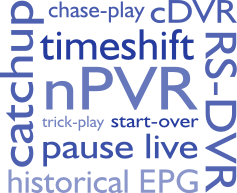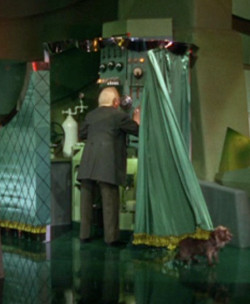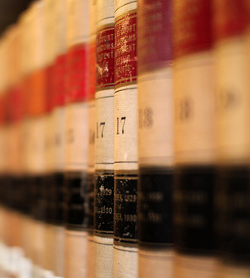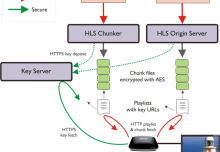
Home disk-based TV recorders (DVRs/PVRs) are becoming nearly ubiquitous for traditional satellite, cable and terrestrial viewing, and consumers love the ability to record, timeshift and pause their favourite TV shows. Â Individual channels are also offering Internet-based catch-up TV services, and in the best of the PVR offerings (such as YouView boxes in the UK) integrate these with the on-box recording functionality in a single seamless Electronic Programme Guide (EPG).
Major operators such as Cablevision in the US are now offering “cloud DVR†or “remote-storage DVRâ€, moving the recording and storage into the network, saving cost in Customer Premises Equipment (CPE) and improving reliability and service, but have had a major legal battle to be able to do so.  So where does all this leave the smaller operator, ISP or content owner wishing to offer similar services to their customers?
This article aims to disentangle the many different types of network-based recording, survey (briefly!) the current legal landscape and (of course!) explain how Packet Ship can help smaller operators and content owners provide these services and compete with the big players.
 What’s in a name?
What’s in a name?
nPVR, catchup, cDVR, timeshift – what does it all mean?  In any new industry there are lots of invented terms thrown about, not always consistently, and often with overlaps.
I’ll try to disentangle the terminology here and then look at how these are implemented both in a traditional home PVR and in a network recorder.
Timeshifting:  A generic term for any way of watching a programme later than when it was broadcast.  Usually however it is done you can pause playback, fast-forward to skip over things you aren’t interested in – often the advertisements! – and rewind sections of interest, just like a DVD.  In the best interfaces you are shown a visually speeded-up view known as trick-play while you’re fast-forwarding or rewinding.
Pause live TV:  Conceptually the simplest form of timeshifting and extremely popular with consumers – you can pause a live TV programme, continue it when you like and fast-forward it.  You can usually rewind back to where you first pressed ‘Pause’, too.  Since you’re watching TV later than when it was broadcast you are timeshifting, and usually, since you are only a little way behind, chase-playing too. Conventionally you press ‘STOP’ to return to the live stream.
Rewind live TV:  A similar idea to Pause Live TV but with the ability to rewind at any time to repeat something of interest, and then continue timeshifted.  This usually means rewinding just for a short time – maybe a few minutes – in contrast to:
Start-over: Â The ability to rewind to the beginning of a programme which is currently being broadcast and play it timeshifted.
Chase play: Â The ability to watch the start of a recording before the programme ends, so that it is still being recorded as well. Â This is something that video tapes could never do!
Catch-up TV: Â The ability to watch recently broadcast programmes timeshifted on demand, without having to decide to record them first. Â Individual channels may offer their own branded portals (e.g. BBC iPlayer), or catch-up services from multiple channels may be integrated in anhistorical or retrospective EPG (e.g. YouView) where you can select programmes from the past just as easily as current ones.
PVR/DVR: Â Personal or Digital Video Recorder1. Â A consumer device containing a hard disk (or sometimes Flash memory or rewriteable DVD) which can record programmes for timeshift, usually on the basis of a selection from a forward looking EPG. Â Most modern PVRs can automatically record all episodes of a series (series link), and the best of them will speculatively record programmes which are predicted (through a recommendations engine) to be of interest.
nPVR/nDVR: A network version of PVR/DVR, recording programmes on demand and keeping them for the long term in network-based storage.  In contrast to cDVR/RS-DVR, this has come to mean keeping a single2 shared copy which as we’ll see is more efficient but legally problematic in most jurisdictions.
cDVR/RS-DVR: A cloud or Remote Storage3 DVR, again recording programmes on demand for long-term storage, but implying that each consumer has their own virtual storage and recordings are not shared, which as we’ll see is believed to be acceptable ‘fair use’ under copyright law but creates major scalability problems for the operator.
 What’s behind the green curtain?
What’s behind the green curtain?
So what is happening behind the scenes to enable all these services?
In a conventional home PVR there is usually a single hard disk in the box which can record one or two channels at a time4.  Recording may be scheduled in advance, or happen instantly when the user presses ‘Pause’.  Some models may keep a permanent circular buffer of the last few minutes’ video5 to allow short-term rewind.  A full catch-up service recording everything really isn’t possible due to the limitations of the number of tuners and disk capacity, but some systems (e.g. YouView) allow access into Internet-based catch-up services integrated into the EPG.
In a cDVR/RS-DVR scenario the functionality is almost identical and the network recording service behaves as if the user had a private disk connected by a ‘very long cord’ – and the current legal case relies on that.  If 1000 users want to record the same programme, the system makes 1000 individual copies, one in each of their private storage areas.  Obviously each user doesn’t really have their own physical disk, but logically they do, and nothing is shared.  Pause live TV is done in the same way; each individual paused stream is considered a separate recording.  Needless to say, this creates a massive scalability problem, both in terms of total capacity and input disk bandwidth, and one which grows linearly with the number of subscribers.  As we’ll see it also causes major problems on the play-back side.  Catch-up and rewind live TV services are not really feasible because to speculatively record everything individually for every user would swamp even the most powerful storage arrays.
In a true nPVR/nDVR service (using shared copies), the process is quite different and (from an engineering point of view) far more sane.  The process starts with the principle of recording everything on every channel and keeping it in a circular buffer for a defined period (typically a few days).  Each programme is only recorded once, which is entirely feasible for a centralised service6.  This then allows a full historical EPG catch-up service up to the circular buffer duration.  Pause and rewind live TV happens ‘for free’ since it’s just a matter of finding the right place in the buffer and playing from there.  PVR functionality where users want to keep programmes for the long term simply involves marking specific programmes to keep indefinitely while any user is interested in them.  Note that users can mark programmes to keep even after they’ve been broadcast, which is a major benefit over a conventional PVR.
 How to break the Internet
How to break the Internet
Kim Kardashian may have infamously tried to “break the Internet†with a certain photograph7, but actually in the modern Internet the more people are looking at the same (ahem) asset, the better the Content Delivery Networks (CDNs) work, since they rely oncaching frequently accessed data near to the consumer – it will be fetched from the origin once when the first person accesses it, but from then on it will be served from CDN caches nearer to the consumer.  The same applies to video, and in the true (shared copy) nPVR scenario, since the recordings are shared, the global CDN infrastructure will cope just fine.
In the cDVR case, though, every recording is a separate file and by definition it will only every be accessed by a single consumer, which essentially makes CDNs redundant. Â The effect of this is that it is effectively impossible to run a cDVR service in any volume on the public Internet. Â ISPs and service operators who are in control of the network can run such a service locally (given enough Web servers and disk bandwidth in their head-end) and this is actually where initial services are happening.
There is a model proposed by Alcatel-Lucent for “CDN assisted private copy†in which an individual recording is made for each user, but on playback this is mapped to a shared copy in the CDN.  This solves the CDN issue but raises a major legal question which I’ll deal with in the next section.
 The legal situation
The legal situation
Clearly from both a technical and consumer experience point of view a shared copy, nPVR service is infinitely preferable to a private copy, cDVR one.  So why would cDVR even be considered?  The answer lies in the arcane legal history and Court interpretations of copyright law, primarily in the USA.  I am not a lawyer, and this should not be taken as legal advice, only a technologist’s understanding of a dynamic situation.
Copyright background
The legal issue stems from the fact that under copyright law any public performance of a workrequires permission from, and often payment to, the rights holder.  In broadcast TV the rights holder may be the original production company, movie studio, or the TV channel itself.  In the first two cases the original rights holder will have granted the TV channel limited rights (permission) to broadcast the programme to a certain audience a certain number of times over a certain period.  Timeshifting changes at least the last two of these, and if good copy protection (DRM) is not in place, there is the danger of expanding the audience to the entire Internet as well.  From the TV channel’s point of view there is the critical point that if consumers are able to skip advertisements, they will, and this reduces the amount they can charge advertisers.
Who remembers Betamax?
Hence the legal debate and case history revolves around the interpretation of ‘public performance’ and whether taking a copy for private use constitutes a fair use exception.  The first and still critically important decision on this was in the Betamax case in the US Supreme Court.  This ruled on two aspects:  Firstly that manufacturers of equipment (such as VCRs) were not liable for any copyright infringement performed by their users as long as the equipment had a “substantial non-infringing useâ€.  Secondly – and more importantly for us – that the act of making a private copy of a programme in order to timeshift it was not infringing in any case, under a fair use exception8.  This decision led directly to the almost ubiquitous use of VCRs and later DVRs in consumer’s homes, and whatever the legal arguments, authorities have not wished to legislate against such a popular mode of consumption.
The very long cord
The first major test of the concept of network-based recording was Cablevision’s RS-DVR.  This is a private copy system, and Cablevision argued that it was just a DVR with the disk attached, as one analyst put it, with a “very long cordâ€.  They were, however, sued in 2006 by just about every major broadcaster and studio, initially successfully in the District Court.  On appeal to the Circuit Court in 2008, however, Cablevision prevailed, and this case is the landmark judgement that allows the concept of cDVR.
It established two limitations for a network recording service to be allowable:  firstly that the recording should be made by the ‘volition’ of the user rather than automatically (speculatively) by the network operator.  Secondly, that the matter of whether it is a ‘public performance’ should be decided by who is the potential audience of that particular copy of the work – and hence a private copy system like RS-DVR is non-infringing.
The first of these automatically discounts any kind of continuous, speculative recording for catch-up or shared pause live TV.  The second could call into question the legality of sharing copies on the playback side as in the Alcatel-Lucent CDN-assisted model, but that will no doubt be for another test case to decide9.
Is shared copy ever possible?
Hence at least in the USA, and many other countries, it would appear in the current state of copyright law only a private copy cDVR system is allowable, unless specific rights are negotiated with content providers – or, as in existing single-channel catch-up services like BBC iPlayer, where it is the content provider or direct licensor which is providing the service.  As Arris point out, it would make most sense for operators to negotiate rights for shared copy distribution of the most popular programmes while defaulting to copyright-friendly private copy for the ‘long tail’.
In some jurisdictions, however – Switzerland and Spain being common examples – a shared copy model is explicitly allowed under local legislation, and both Swisscom and Telefonica are offering full nPVR services to their customers – very successfully, which shows the potential demand and cost savings of such a model.  So is there any hope of such explicit legislation in the US and elsewhere?  Legal hurdles aside, one has to look at who stands to gain and who to lose from such an arrangement.
 nPVR: Winners and losers?
nPVR: Winners and losers?
The companies that sued (and eventually lost) in the Betamax and Cablevision cases presumably did so because they thought their economic rights would be damaged by the change in consumer behaviour.  It turned out that the advent of VCRs for home recording also promoted a huge upswing in purchase of pre-recorded movies and TV series, so perhaps the content owners’ original fears were not justified.  With the advent of home PVRs and now cDVR services the biggest losers are the broadcasters, from the ability of their viewers to skip adverts, which potentially reduces their advertising footprint and hence revenue.  Mitigating that, however, is the ability of network-based services to target advertisements individually, and to place them dynamically within the EPG, in pre- and post-rolls, as secondary spots and all the myriad ways of placing ads that our familiar Internet services are so good at.  What is clear, however, is that this is an inevitable process and one that is happening with existing technology.
It is much harder to think of anyone who loses from a switch from private copy cDVR to true shared copy nPVR, except possibly disk manufacturers! Â There are certainly plenty who stand to gain: Â Consumers, because of the additional services such as catch-up, rewind live TV and after-the-fact recording that can be offered, on all their devices; Â operators, because the massive saving in storage requirement; Â other users of the Internet, due to avoidance of pollution of CDN caches with private copy content. Â The effect on content owners is at worst neutral (compared to PVR/cDVR which is here anyway) and arguably by making their content much easier to access it can give them back the audience they have lost to Internet services and poor quality user-generated content.
There is also an environmental impact:  Home DVRs are relatively power hungry, at least while active, and removing unreliable spinning drives from consumer electronics saves in materials and waste.  A cDVR service requires massive storage arrays with corresponding power, space and cooling load, but a shared-copy nPVR service is about as efficient in all of these things as it is possible to be.
So we live in hope of legislators one day seeing sense, either driven from a strong economic analysis of the benefits or, perhaps more likely, as with VCRs, simply following a trend of consumer behaviour that is already firmly established.
 How Packet Ship can help
How Packet Ship can help
The above quick survey of the landscape is about as far as we can go in helping you navigate the complex legal situation;  I hope it helps at least define your direction of travel.  Where we can definitely help you, however, is in the technology:
Our OverView:Origin product supports all the services we’ve mentioned, both in shared copy and private copy modes, and is specifically designed for smaller ISPs, operators and content owners to be able to offer these services in competition with the Big Guys.  It can package directly into HLS or MPEG-DASH, with optional encryption, or be used as a back end for our StreamlineRTSP video server.
Our OverView:Guide middleware complements this, and provides a multi-device EPG and nPVR/cDVR interface that exactly mimics the home PVR that consumers are used to, but all run from the cloud.
Finally our OverView:DRM system uses content industry-approved Marlin technology to secure both your revenues and your content providers’ rights.
The three products can be used individually and integrated with third-party products, but also form a pre-integrated solution giving you a fast and low-risk route to market.
For more information, or just to discuss your journey through this territory, please contact us.
- The PVR/DVR difference seems to be regional – DVR is more popular in the USA (possibly because TiVo have trademarked Personal Video Recorder) while PVR seems more common in Europe.  I’ll stick to the British usage (as with ‘programme’, which has no doubt annoyed my American readers already)
- Actually there may be a few, for resilience and scalability, but not one per user
- RS-DVR is Cablevision’s term
- Depending on the number of tuners – some home gateway devices have up to 6
- Sometimes in memory, to save disk access
- Standard definition broadcasts typically take around 50GB per day per channel – hence a 7 day circular buffer of 100 channels takes 35TB of storage with 500Mbit/sec of ingest bandwidth – which is a relatively small disk array for a central data centre
- Paper magazine who ran the Kardashian photo were more concerned it would break their own servers – a Slashdot effect – but were actually very well prepared (SFW, but with NSFW links if you really must)
- There was significant disagreement between the Justices about whether private copy should be allowed, which has been reflected in the later history
- I suspect such a case would hinge on whether the CDN is treated as part of the service or as part of the ‘common carrier’ in the ISP.  I wouldn’t like to take bets either way!


